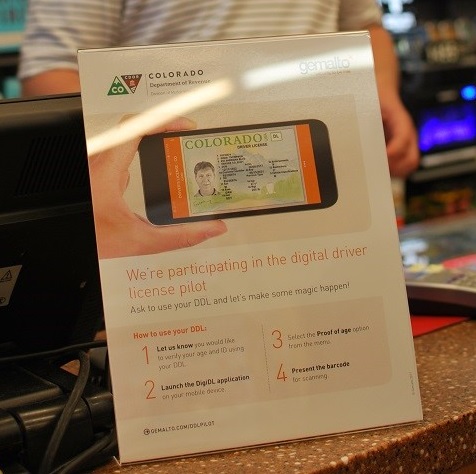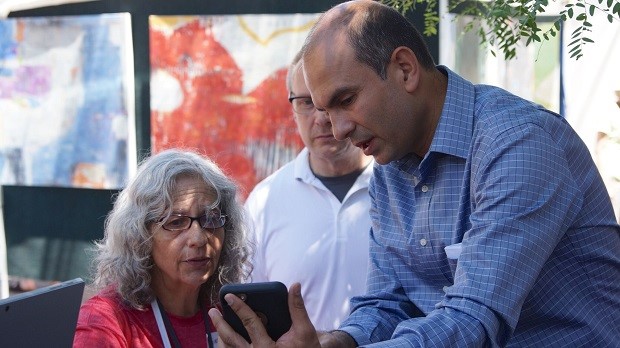
In November 2016, Gemalto received a government grant to pilot a smartphone-based digital driver’s licenses (DDL) within four US jurisdictions. Since then, we’ve been hard at work with Colorado, Idaho, Maryland, and Washington D.C. Last month, Colorado was the first state to start their live activity – see below for how the pilot has gone so far.
What are we testing? The Digital Driver’s Licences Pilot Use Cases
A digital driver’s license is a highly secure, supplemental version of your physical driver’s license or ID card that is stored on your smartphone. To test the effectiveness of this new form of identity, the Colorado pilot focused on three main use cases:
- Enrollment for a DDL and getting it working on your phone
- Presenting the digital driver’s license to law enforcement
- Displaying your license for age verification for purchase of age-restricted goods or entry into venues with age restrictions
If you’d like to learn how a DDL works, take a look at our infographic here.
Throughout the pilot, we surveyed and interviewed participants. We will be publishing our insights and lessons learned later this year, so make sure you keep an eye out for updates. So, how did we run the trial?
First Step – Enrolling and Testing the DDL at the DMV
To kick things off, we set up an enrollment workstation at a new Denver DMV (Department of Motor Vehicles) facility for several of our pilot volunteers – mostly made up of DMV employees – to enroll and access their new DDLs.
In a very similar process to the real-life scenario, our volunteers had their license information captured and pictures taken. Each volunteer then downloaded the DigiDL app on their device, completed the pairing process with their DL profile, and securely downloaded their digital driver’s license onto their phone. Once downloaded, the DDL is protected by a fingerprint or PIN code, to preserve credential security.
Several key fraud investigations personnel were on site to give us feedback and perspective on some of the issues they encounter every day with fraudulent credentials and purported identity thieves that come into the DMV.

Next at the DMV, pilot participants went through a simulated scenario of presenting their DDL for law enforcement verification. A top special investigator from the Colorado gaming control division walked us through interactions he would have in his day-to-day job of verifying the identity and age of those wishing to partake at Colorado’s gambling and gaming entertainment venues. This test-case illustrated how effective digital driver’s license’s can be at helping verify in-state (and eventually out-of-state) credentials in a more reliable and error-proof manner.
Second Step – Taking the Digital Drivers Licences to Commercial Environments
Over several days during the Colorado DDL pilot, we took the DDL to the streets and put it to the test in real commercial environments. We started at Capitol Convenience, a trendy convenience store near the state capitol in downtown Denver.

To buy age-restricted goods such as alcohol, cashiers will ask to see your ID. They need to verify you are presenting a valid ID, you are its rightful owner and that you are above the age restriction. Unlike a law enforcement scenario, the cashier doesn’t need to see your full name, address, or exact date of birth, so those details are hidden for privacy’s sake.
To confirm validity, the cashier scans your DDL and receives real-time approval that your ID is real and you are above the age restriction. The cashier can also perform a visual confirmation that you are indeed the person pictured on the DDL.
Multiple pilot participants went through the age verification scenario at Capitol Convenience, and we took time to discuss the use case at length with both the store owner and check-out manager. While initially skeptical, the store owner was pleased to find the solution to be easy, fast and secure.

Three additional merchants – King Sooper’s, Amendment XXI and AppleJack Wine & Spirits – also took part in the pilot. With their great cooperation, we managed to repeat the age verification test with many of our participants as they bought restricted goods. We were thrilled with the opportunity to test a wide variety of smartphone devices in multiple environments and learn from each scenario.

Buying Lottery Tickets? Show your DDL
The Colorado Lottery’s Denver Claim Center is where you go to buy lottery tickets and if you’re lucky – to claim your prize. But you need to prove your age when you do that, so we headed over to try to use digital driver’s license’s there.
Fortunately, staff at the claim center were excited to see and test the new technology. After they ran through the test scenario, we surveyed the group and held individual interviews to gather their comments and feedback.

Colorado embraces DDLs at the Cherry Creek Arts Festival
While the pilot participants were pre-selected in the specific use cases above, we also wanted to see what the everyday Coloradan thought about DDL. So, we tagged along with the Colorado Lottery Division’s Dream Machine truck as it set out for the Cherry Creek Arts Festival in Denver, which attracts 350,000 visitors over the course of the three-day event, and set up a demo of how a DDL is used in proof-of-age scenarios.

Throughout the day we spoke with festival goers of all ages, backgrounds, demographics and technology profiles to gather their thoughts about digital driver’s licenses. Almost everyone was, at the very least, interested in learning about and seeing the new technology, and this audience was clearly excited about the prospect of having a version of their driver’s license on their phones.

We’ll be sharing additional conclusions and results as we compile them, but it’s safe to say that the first DDL pilot event was a success! Next, the digital driver’s license pilot commences in Maryland and Washington D.C., so keep an eye out for more updates.
The pilot ended in May 2019. Since November 2019, the State of Colorado has added a digital driver license functionality to their MyColorado app. This app was not developed by Gemalto and our participation in the project finished at the end of the pilot.


